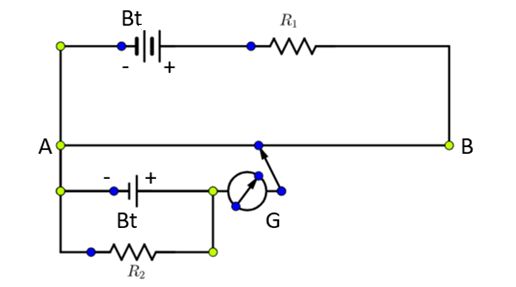
In a potentiometer experiment of a cell of emf $1.25V$ gives a balancing length of $30cm$. If the cell is replaced by another cell, the balancing length is found to be $40cm$. What is the emf of the second cell?
$A.{\text{ }} \simeq 1.57{\text{ }}V$
\[B.{\text{ }} \simeq 1.67{\text{ }}V\]
\[C.{\text{ }} \simeq 1.47{\text{ }}V\]
\[D.{\text{ }} \simeq 1.37{\text{ }}V\]
Answer
572.1k+ views
Hint: The potential difference that tends to increase the electric current is known as electromotive force. By finding the electromotive force of the cells and their balancing lengths respectively we are able to find the solution for this question.
Formula used:
\[\dfrac{{{E_1}}}{{{E_2}}} = \dfrac{{{l_1}}}{{l2}}\]
Where, \[{E_1},{E_2}\] is the emf of the secondary cells
${L_1},{L_2}$ is the balancing length of the potentiometer
Complete step by step answer:
Let us consider the values given in the above problem.
Given that in a potentiometer experiment of a cell of emf $1.25V$ gives a balancing length of $30cm$.
We know that if the cell is replaced by another cell, the balancing length is found to be 40 cm.
Let us consider ${E_1}$ be the cell of emf $1.25V$having balancing length ${l_1} = 30cm$ and ${E_2}$ be another cell having balancing length ${l_2} = 40cm$.
We can use the formula to compare emfs of two cells by individual cell method,
\[ \Rightarrow \dfrac{{{E_1}}}{{{E_2}}} = \dfrac{{{l_1}}}{{l2}}\]
We shall now substitute the values for we get,
$ \Rightarrow {E_1} = 1.25V$
$ \Rightarrow {l_1} = 30cm{\text{ }}$
$ \Rightarrow {l_2} = 40cm$
$ \Rightarrow \dfrac{{1.25}}{{E2}} = \dfrac{{30}}{{40}}$
$ \Rightarrow E_2 = \dfrac{{1.25 \times 40}}{{30}}$
$ \Rightarrow E_2 = 1.6667V{\text{ }}$
$\therefore \simeq {\text{1}}.67{\text{ }}V$
Emf of the second cell $ \simeq 1.67V$. Hence, Option(B) is the required answer.
Additional information:
We know that the potentiometer is an instrument that is used to measure an unknown emf by comparison with known emf.
Potentiometer uses the null deflection method.
The fall of potential per unit length of potentiometer wire i.e. the potential gradient of wire is constant. This is the principle of the potentiometer.
The potentiometer is used to measure the emf of a cell, to compare EMFs of two cells, and to determine the internal resistance of a cell.

In the diagram:
$B_t$- batteries
${R_1},{R_2}$- Resistances
$G$- galvanometer.
Note:
When combination method or sum and difference method is used to compare the emfs of two cells the formula used is \[\dfrac{{{E_1}}}{{{E_2}}} = \dfrac{{{L_1} + {L_2}}}{{{L_1} - {\text{ }}{L_2}}}\] where ${E_1}$ is the emf of cell having balancing ${L_1}$ and ${E_2}$ is the emf of cell having balancing ${L_2}$.
Formula used:
\[\dfrac{{{E_1}}}{{{E_2}}} = \dfrac{{{l_1}}}{{l2}}\]
Where, \[{E_1},{E_2}\] is the emf of the secondary cells
${L_1},{L_2}$ is the balancing length of the potentiometer
Complete step by step answer:
Let us consider the values given in the above problem.
Given that in a potentiometer experiment of a cell of emf $1.25V$ gives a balancing length of $30cm$.
We know that if the cell is replaced by another cell, the balancing length is found to be 40 cm.
Let us consider ${E_1}$ be the cell of emf $1.25V$having balancing length ${l_1} = 30cm$ and ${E_2}$ be another cell having balancing length ${l_2} = 40cm$.
We can use the formula to compare emfs of two cells by individual cell method,
\[ \Rightarrow \dfrac{{{E_1}}}{{{E_2}}} = \dfrac{{{l_1}}}{{l2}}\]
We shall now substitute the values for we get,
$ \Rightarrow {E_1} = 1.25V$
$ \Rightarrow {l_1} = 30cm{\text{ }}$
$ \Rightarrow {l_2} = 40cm$
$ \Rightarrow \dfrac{{1.25}}{{E2}} = \dfrac{{30}}{{40}}$
$ \Rightarrow E_2 = \dfrac{{1.25 \times 40}}{{30}}$
$ \Rightarrow E_2 = 1.6667V{\text{ }}$
$\therefore \simeq {\text{1}}.67{\text{ }}V$
Emf of the second cell $ \simeq 1.67V$. Hence, Option(B) is the required answer.
Additional information:
We know that the potentiometer is an instrument that is used to measure an unknown emf by comparison with known emf.
Potentiometer uses the null deflection method.
The fall of potential per unit length of potentiometer wire i.e. the potential gradient of wire is constant. This is the principle of the potentiometer.
The potentiometer is used to measure the emf of a cell, to compare EMFs of two cells, and to determine the internal resistance of a cell.

In the diagram:
$B_t$- batteries
${R_1},{R_2}$- Resistances
$G$- galvanometer.
Note:
When combination method or sum and difference method is used to compare the emfs of two cells the formula used is \[\dfrac{{{E_1}}}{{{E_2}}} = \dfrac{{{L_1} + {L_2}}}{{{L_1} - {\text{ }}{L_2}}}\] where ${E_1}$ is the emf of cell having balancing ${L_1}$ and ${E_2}$ is the emf of cell having balancing ${L_2}$.
Recently Updated Pages
A man running at a speed 5 ms is viewed in the side class 12 physics CBSE

The number of solutions in x in 02pi for which sqrt class 12 maths CBSE

State and explain Hardy Weinbergs Principle class 12 biology CBSE

Write any two methods of preparation of phenol Give class 12 chemistry CBSE

Which of the following statements is wrong a Amnion class 12 biology CBSE

Differentiate between action potential and resting class 12 biology CBSE

Trending doubts
What are the major means of transport Explain each class 12 social science CBSE

Which are the Top 10 Largest Countries of the World?

Draw a labelled sketch of the human eye class 12 physics CBSE

Explain sex determination in humans with line diag class 12 biology CBSE

Explain sex determination in humans with the help of class 12 biology CBSE

Differentiate between homogeneous and heterogeneous class 12 chemistry CBSE




